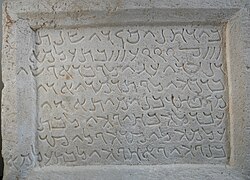
Back أبجدية تدمرية Arabic Alfabet de Palmira Catalan Alfabeto palmireno Spanish الفبای تدمری Persian Alphabet palmyrénien French Abjad Tadmur ID Alfabeto palmireno Italian パルミラ文字 Japanese Alfabeta palmira LFN Палмирска азбука Macedonian
| Palmyrene alphabet | |
|---|---|
 Palmyrene inscribed tablet in the Musée du Louvre | |
| Script type | |
Time period | 100 BCE to 300 CE |
| Direction | Right-to-left script |
| Languages | Palmyrene Aramaic |
| Related scripts | |
Parent systems | Proto-Sinaitic alphabet
|
Sister systems | Ammonite Brāhmī Edessan[1] Elymaic[1] Hatran[1] Hebrew Mandaic[1] Nabataean[1] Pahlavi Parthian |
| ISO 15924 | |
| ISO 15924 | Palm (126), Palmyrene |
| Unicode | |
Unicode alias | Palmyrene |
| U+10860–U+1087F Final Accepted Script Proposal | |

The Palmyrene alphabet was a historical Semitic alphabet used to write Palmyrene Aramaic. It was used between 100 BCE and 300 CE in Palmyra in the Syrian desert. The oldest surviving Palmyrene inscription dates to 44 BCE.[2] The last surviving inscription dates to 274 CE, two years after Palmyra was sacked by Roman Emperor Aurelian, ending the Palmyrene Empire. Use of the Palmyrene language and script declined, being replaced with Greek and Latin.
The Palmyrene alphabet was derived from cursive versions of the Aramaic alphabet and shares many of its characteristics:[3][4]
- Twenty-two letters with only consonants represented
- Written horizontally from right-to-left
- Numbers written right-to-left using a non-decimal system
Palmyrene was normally written without spaces or punctuation between words and sentences (scriptio continua style).
Two forms of the Palmyrene alphabet were developed: The rounded, cursive form derived from the Aramaic alphabet and later a decorative, monumental form developed from the cursive Palmyrene.[2] Both the cursive and monumental forms commonly used orthographic ligatures.[4]
- ^ a b c d e Daniels, Peter T.; Bright, William, eds. (1996). The World's Writing Systems. Oxford University Press, Inc. pp. 89. ISBN 978-0195079937.
- ^ a b "Palmyrenian alphabet". Encyclopædia Britannica.
- ^ Daniels, Peter T.; Bright, William, eds. (1996). The World's Writing Systems. Oxford University Press, Inc. ISBN 978-0195079937.
- ^ a b Everson, Michael (17 August 2010). "N3867R2: Proposal for encoding the Palmyrene script in the SMP of the UCS" (PDF). Retrieved 20 August 2016.